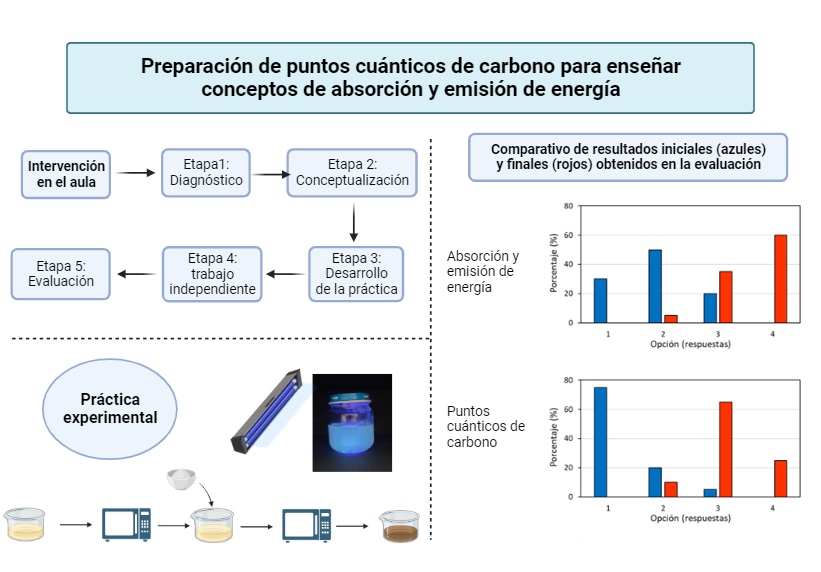Preparación de puntos cuánticos de carbono para enseñar conceptos de absorción y emisión de energía
Conteúdo do artigo principal
Resumo
Este artículo presenta una estrategia didáctica innovadora implementada para estudiantes de química básica en la educación media con el objetivo de enseñar conceptos abstractos y difíciles de entender en química, de una forma más atractiva y accesible. La estrategia se basa en el uso de experiencias prácticas en el aula, utilizando la nanotecnología como herramienta diferenciadora. Se centra en la preparación de puntos cuánticos de carbono mediante un proceso sencillo pero fascinante, para abordar experimentalmente los conceptos de absorción y emisión de energía. La estrategia comienza con la identificación de conceptos previos necesarios y la introducción de nuevos conceptos relacionados con los puntos cuánticos de carbono. A continuación, tiene lugar la fase de desarrollo, en la que los alumnos siguen una guía de trabajo para preparar los puntos cuánticos y discuten la relación entre lo observado y los conceptos aprendidos. Por último, se utiliza una herramienta de evaluación para medir los resultados obtenidos, y se demuestra que la estrategia ha mejorado significativamente la comprensión de conceptos como la absorción y la emisión de energía. Adicionalmente, los alumnos tienen la oportunidad de aprender sobre nanotecnología y crear estructuras con impacto tecnológico y medioambiental. Se ofrece un enfoque refrescante y atractivo del aprendizaje de la química.
Detalhes do artigo
Citas en Dimensions Service
Referências
Arroyave Rave, Y. (2021). Saberes pedagógico-didácticos experienciales en Colombia: desde perspectivas hermenéuticas, abductivas y narrativas. Revista Venezolana de Gerencia, 26(5 Edición Especial), 170–189. https://doi.org/10.52080/rvgluz.26.e5.12
Bautista, A. (2021). STEAM education: contributing evidence of validity and effectiveness (Educación STEAM: aportando pruebas de validez y efectividad). Infancia y Aprendizaje, 44(4), 755–768. https://doi.org/10.1080/02103702.2021.1926678
Cadrecha, M. (1990). John Dewey: Propuesta de un modelo educativo. Aula Abierta No. 55, 61–87.
Furió, C & Furió, C. (2000) Dificultades conceptuales y epistemológicasen el aprendizaje de los procesos químicos. Educación Química, 11 (3) 300 – 308. https://doi.org/10.22201/fq.18708404e.2000.3.66442
Gaviria Cortés, D. F., Chaverra Fernández, B. E., Ospina Ospina, E. V., Uribe Pareja, I. D., Muriel Echavarría, J. M., Moreno López, J. D., Cardona Mejía, L. M., & Bustamante Castaño, S. A. (2023). Cómo son y qué hacen los buenos profesores. Sus voces y las de sus estudiantes. Fondo Editorial FCSH. https://doi.org/10.17533/978-628-7592-65-0
Instituto Colombiano para la Evaluación de la Educación (Icfes). (2022). Informe nacional de resultados de las pruebas Saber 3°, 5° ,7º y 9°. Aplicación 2022. https://www.icfes.gov.co/documents/39286/19845423/Informe_saber_359_06_2022.pdf
Jorns, M., & Pappas, D. (2021). A review of fluorescent carbon dots, their synthesis, physical and chemical characteristics, and applications. In Nanomaterials (Vol. 11, Issue 6). MDPI AG. https://doi.org/10.3390/nano11061448
Khamhaengpol, A., Sriprom, M., & Chuamchaitrakool, P. (2021). Development of STEAM activity on nanotechnology to determine basic science process skills and engineering design process for high school students. Thinking Skills and Creativity, 39, 1–7. https://doi.org/10.1016/j.tsc.2021.100796
Li, Y., Zhong, X., Rider, A. E., Furman, S. A., & Ostrikov, K. (2014). Fast, energy-efficient synthesis of luminescent carbon quantum dots. Green Chemistry, 16(5), 2566–2570. https://doi.org/10.1039/c3gc42562b
Miguel Díaz, M. de. (2005). Modalidades de enseñanza centradas en el desarrollo de competencias: orientaciones para promover el cambio metodológico en el espacio europeo de educación superior. Servicio de Publicaciones. Universidad de Oviedo.
Ministerio de educación nacional. (2022). Niveles de desempeño Prueba de Ciencias Naturales Saber 11. https://www.icfes.gov.co/documents/39286/10065230/Niveles+de+desempe%C3%B1o+Ciencias+Naturales+Saber+11.%C2%BA+2022.pdf
Molano, A., Trujillo, L., González, N., Ortega, Ó., Soler, S., Benjumea, R., Caro, P., Montaño, C., Árevalo, C., Pérez, D., Durán, C., Niño, H., Mejía, L., Leyton, A., Ramírez, L., Contreras, J., Molano, A., Cortes, J., & Bello, A. (2022). Instituto Colombiano para la Evaluación de la Educación (Icfes). Informe nacional de resultados del examen Saber 11o. https://www.icfes.gov.co/documents/39286/1689945/Informe_nacional_de+resultados_Saber11_2021.pdf/68ccc718-dc51-71de-5693-bb907477fa87?t=1655481600171
Nakamatsu, J. (2012). Reflexiones sobre la enseñanza de la Química. En Blanco y Negro , 3(2), 38–46. https://revistas.pucp.edu.pe/index.php/enblancoynegro/article/view/3862
OECD. (2019). PISA 2018 Country note - Colombia, PISA, OECD Publishing, Paris, https://www.oecd.org/pisa/publications/PISA2018_CN_COL.pdf. OECD. https://doi.org/10.1787/5f07c754-en
Ordaz González, G. J., & Mostue, M. B. (2018). Los caminos hacia una enseñanza no tradicional de la química. Actualidades Investigativas En Educación, 18(2). https://doi.org/10.15517/aie.v18i2.33164
Ríos Quintero, C. (2021). Síntesis y caracterización de carbon-dots a partir de una fuente renovable. Universidad EIA. https://repository.eia.edu.co/entities/publication/87f985bc-9644-42ae-9d18-c065c9ae4dcb
Ruiz, G. (2013). La teoría de la experiencia de John Dewey: significación histórica y vigencia en el debate teórico contemporáneo. Foro de Educación, 11(15), 103–124. https://doi.org/10.14516/fde.2013.011.015.005
Runge Peña, A. K. (2013). Didáctica: una introducción panorámica y comparada. Itinerario Educativo, 27(62), 201–240. https://doi.org/10.21500/01212753.1500
Santos, C. I. L., Ferreira, J. C. A., Cunha, L. R. C., Vaz, R., & Schiavon, M. A. (2020). Síntese e caracterização de pontos quânticos ambientalmente amigáveis, um meio simples de exemplificar e explorar aspectos da nanociência e nanotecnologia em cursos de graduação. Quimica Nova, 43(6), 813–822. https://doi.org/10.21577/0100-4042.20170558
Vaz, R., Vieira, K. O., Machado, C. E., Ferrari, J. L., & Schiavon, M. A. (2015). Preparação de pontos de carbono e sua caracterização óptica: Um experimento para introduzir nanociência na graduação. Quimica Nova, 38(10), 1366–1373. https://doi.org/10.5935/0100-4042.20150150
Westbrook, R. (1993). Perspectivas: revista trimestral de educación comparada. UNESCO.
Widya, Rifandi, R., & Laila Rahmi, Y. (2019). STEM education to fulfil the 21st century demand: A literature review. Journal of Physics: Conference Series, 1317(1). https://doi.org/10.1088/1742-6596/1317/1/012208

Educación Química por Universidad Nacional Autónoma de México se distribuye bajo una Licencia Creative Commons Atribución-NoComercial-SinDerivar 4.0 Internacional.
Basada en una obra en http://www.revistas.unam.mx/index.php/req.




